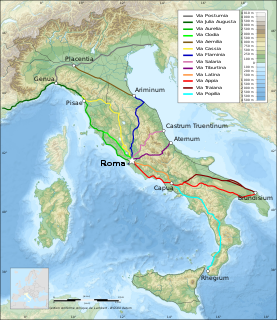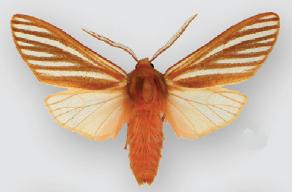
The Via Aemilia was a trunk Roman road in the north Italian plain, running from Ariminum (Rimini), on the Adriatic coast, to Placentia (Piacenza) on the river Padus (Po). It was completed in 187 BC. The Via Aemilia connected at Rimini with the Via Flaminia to Rome, which had been completed 33 years earlier.
Aemilia is a large main-belt asteroid. Aemilia was discovered by the French brothers Paul Henry and Prosper Henry on January 26, 1876. The credit for this discovery was given to Paul. It is probably named after the Via Aemilia, a Roman road in Italy that runs from Piacenza to Rimini.
Aemilia Lepida is the name of several ancient Roman women belonging to the gens Aemilia. The name was given to daughters of men belonging to the Lepidus branch of the Aemilius family. The first Aemilia Lepida to be mentioned by Roman historians was the former fiancée of the younger Cato. Subsequent Aemiliae are known because of their marriages.

The Basilica Aemilia was a civil basilica in the Roman Forum, in Rome, Italy. Today only the plan and some rebuilt elements can be seen. The Basilica was 100 meters (328 ft) long and about 30 meters (98 ft) wide. Along the sides were two orders of 16 arches, and it was accessed through one of three entrances.

The Via Aemilia Scauri was an ancient Roman road built by the consul Marcus Aemilius Scaurus during his term as Censor in 109 BC.

Aemilia Tertia, also known as Aemilia Paulla, was the wife of the Roman consul and censor Scipio Africanus. She was the daughter, possibly the third surviving daughter, of the consul Lucius Aemilius Paullus and the sister of the consul Lucius Aemilius Paulus Macedonicus.
Emilia is a historic region of northern Italy, which approximately corresponds to the western and north-eastern portions of the modern region Emilia-Romagna, with the area of Romagna forming the remainder of the modern region.
Aemilia is a genus of tiger moths in the family Erebidae. It was initially named Ameles, but this name properly refers to a praying mantis genus.

Pseudohemihyalea is a genus of arctiine tussock moths in the Erebidae family. While the caterpillars of most species of Pseudohemihyalea feed on broad-leaved trees, the P. ambigua group has larvae that feed on conifers. Their forewing coloration has accordingly evolved to light-and-dark lengthwise striping, giving better camouflage among the slim needles of the host plants. In this, they seem to be convergent to certain geometer moths, such as Caripeta piniata or Sabulodes niveostriata.

Aemilia ockendeni is a moth of the family Erebidae. It is found in Peru and Bolivia.
Aemilia asignata is a moth of the family Erebidae. It was described by George Hampson in 1901. It is found in Brazil.
Aemilia crassa is a moth of the family Erebidae. It was described by Francis Walker in 1865. It is found in Colombia.
Aemilia mincosa is a moth of the family Erebidae. It was described by Druce in 1906. It is found in Peru.
Aemilia pagana is a moth of the family Erebidae. It was described by Schaus in 1894. It is found in Brazil.
Aemilia rubriplaga is a moth of the family Erebidae. It was described by Francis Walker in 1855. It is found in Venezuela.
Aemilia tabaconas is a moth of the family Erebidae. It was described by James John Joicey and George Talbot in 1916. It is found in Peru.
Aemilia testudo is a moth of the family Erebidae. It was described by George Hampson in 1901. It is found in Peru.

Porticus Aemilia was a portico in ancient Rome. It was one of the largest commercial structures of its time and functioned as a storehouse and distribution center for goods entering the city via the Tiber river.







